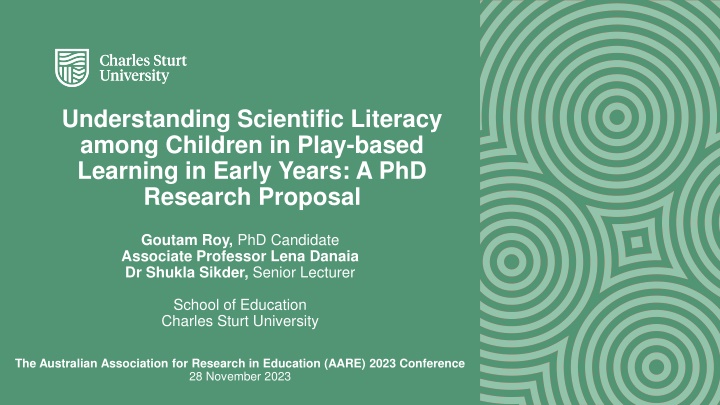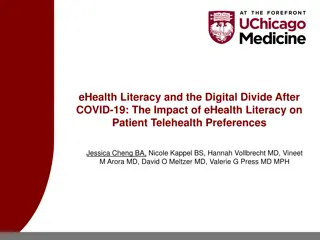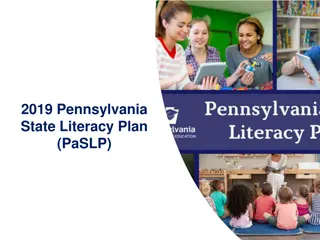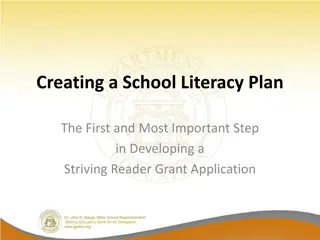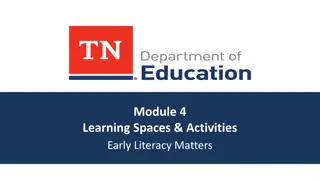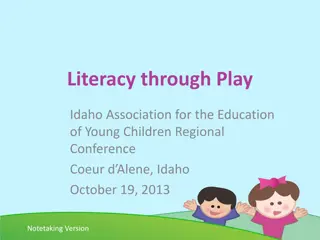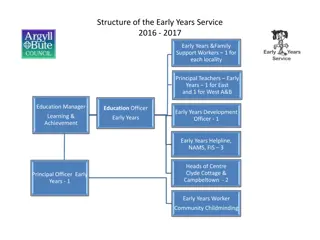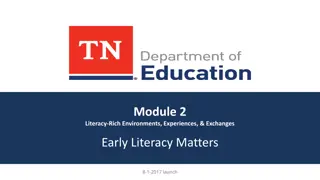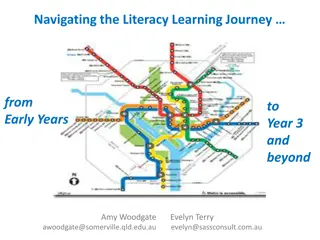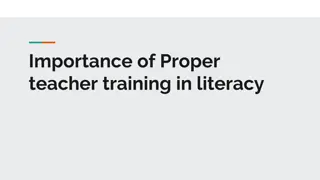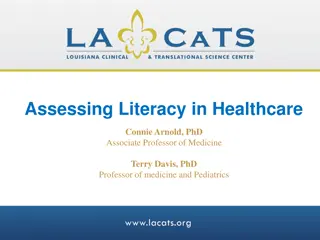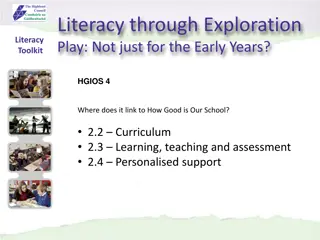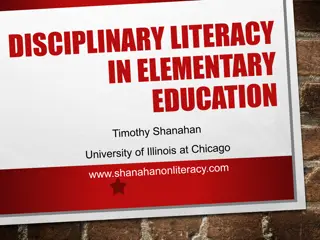Enhancing Scientific Literacy in Early Years Play-Based Learning
This PhD research proposal explores scientific literacy among children in play-based learning, focusing on everyday concepts and their application to scientific understanding. The study aims to implement Vygotsky's sociocultural theory to enhance children's scientific literacy through Vision 1 and Vision 2 approaches, fostering a scientific community and relevance to daily life activities.
Download Presentation

Please find below an Image/Link to download the presentation.
The content on the website is provided AS IS for your information and personal use only. It may not be sold, licensed, or shared on other websites without obtaining consent from the author.If you encounter any issues during the download, it is possible that the publisher has removed the file from their server.
You are allowed to download the files provided on this website for personal or commercial use, subject to the condition that they are used lawfully. All files are the property of their respective owners.
The content on the website is provided AS IS for your information and personal use only. It may not be sold, licensed, or shared on other websites without obtaining consent from the author.
E N D
Presentation Transcript
Understanding Scientific Literacy among Children in Play-based Learning in Early Years: A PhD Research Proposal Goutam Roy, PhD Candidate Associate Professor Lena Danaia Dr Shukla Sikder, Senior Lecturer School of Education Charles Sturt University The Australian Association for Research in Education (AARE) 2023 Conference 28 November 2023
We acknowledge and pay our respects to the traditional custodians of the Naarm lands on which we meet today. We also pay respect to their Elders past, present and emerging and extend that respect to other Indigenous Australians who are present with us here today. I thank the Australian Government Research Training Programme (International) Scholarship for funding my PhD study. Charles Sturt University is an Australian University, TEQSA Provider Identification: PRV12018. Charles Sturt University CRICOS Provider Number: 00005F. Presentation title 2
Scientific literacy: Concepts Learning from everyday context (Roberts, 2007) Association between learning and applying (Holbrook & Rannikmae, 2009) Everyday concept and scientific concept (Sikder & Fleer, 2018; Vygotsky, 1987) Representation of acar parking (P 22, CSU) Representation of a roundabout Representation of a cake Charles Sturt University is an Australian University, TEQSA Provider Identification: PRV12018. Charles Sturt University CRICOS Provider Number: 00005F. Presentation title 3
Scientific literacy: Visions Vision 1 Vision 2 Associated with children s cultural and social settings (Vygotsky, 1978) Extends the content in practising, extending and refining the knowledge (National Research Council, 2007; Norris & Philips, 2003) Scientific literacy with Vision 1 and Vision 2 (Holbrook & Rannikmae, 2009; Roberts, 2007) Create scientific community through science content To educate people considering their context Related to everyday life activities Not related to the application Transformation of science content to students Relevance of learning in everyday life Vision 1 and Vision 2 approaches (Roberts, 2007) Charles Sturt University is an Australian University, TEQSA Provider Identification: PRV12018. Charles Sturt University CRICOS Provider Number: 00005F. Presentation title 4
Scientific literacy: Definition Establishing relationship to the contexts Learning science content and knowledge Applying in real-life situations Scientific literacy The definition of scientific literacy for the study Charles Sturt University is an Australian University, TEQSA Provider Identification: PRV12018. Charles Sturt University CRICOS Provider Number: 00005F. Presentation title 5
Cultural-historical theory: Concept The development of the human mind is not a biological, but rather a cultural-social process (Veresov, 2010) Children s development needs to be aligned with social and cultural-historical context (Rogoff, 2003) Children s learning journey is two-fold: on the social level (interpsychological) and inside the children (intrapsychological) (Vygotsky, 1978) Culture-specific play activities help the children develop scientific literacy (Sliogeris & Almeida, 2019; Vygotsky, 1966; Vygotsky, 1987) Charles Sturt University is an Australian University, TEQSA Provider Identification: PRV12018. Charles Sturt University CRICOS Provider Number: 00005F. Presentation title 6
Cultural-historical theory: ZPD and SC&EC Beyond children's capacity Scientific concept What children can learn with the help of skilled peers or adults - Develop from everyday play-based activities - Child s own reflection from everyday experience - Move from concrete to abstract form - Develop from structured activities - Increase generalization - Move from abstract form to concrete What children can learn independently Everyday concept Everyday concept and scientific concept as a dialectical process (Vygotsky, 1987) Zone of Proximal Development (Vygotsky, 1978; Vygotsky, 1998) Charles Sturt University is an Australian University, TEQSA Provider Identification: PRV12018. Charles Sturt University CRICOS Provider Number: 00005F. Presentation title 7
Cultural-historical theory: Play Use of rules in everyday life they observe in their play at home or schools Consciously make own meanings through play and analyse and articulate the rules and roles of activities (Colliver & Fleer, 2016) Discovery science learning with materials Applying science learning in everyday life Spontaneo us play and everyday science Play and intentional teaching of science Guided science inquiry in play Science process skills Science learning Scientific literacy Play A continuum between play-based learning and scientific literacy (Based on Fleer, 2022) Charles Sturt University is an Australian University, TEQSA Provider Identification: PRV12018. Charles Sturt University CRICOS Provider Number: 00005F. Presentation title 8
Synopsis of the literature: Factors of scientific literacy Factors related to developing scientific literacy Home and context Parents Educational settings Educators Play as part of the culture in some contexts (Jiang & Han, 2015) Use of different language at home, lack of learning environment, use of fewer materials, higher number of siblings (Hao & Fleer, 2017; K hler et al. 2020; Martin et al., 2012; ent rk, 2017) Parental education (K hler et al. 2020; Martin et al., 2012; ent rk, 2017) Active involvement of parents (Hao & Fleer, 2017; Sikder, 2018; Sikder & Fleer, 2017) Parents' positive approach towards play activities (Jiang & Han, 2015) Learning activities in the educational institutions (Bauer & Booth, 2019; Pereira et al., 2020) Awareness of applying scientific knowledge in daily activities (Rubini et al., 2019) Competencies and educational background (Pereira et al., 2020) Lack of understanding (Rubini et al., 2019; Tuttle et al., 2016) Perceptions not directly related (Sarkar & Corrigan, 2014) Emotional attachment and contradictions (Fleer, 2021) Parental perception and home practices yet to be understood Not aligned with Vision 2 Charles Sturt University is an Australian University, TEQSA Provider Identification: PRV12018. Charles Sturt University CRICOS Provider Number: 00005F. Presentation title 9
Research gaps Limited focus on educators and parental perceptions Minimal studies are on early years, play-based setting, and using cultural- historical lens Research focused on the science teaching method (Sa kes et al., 2012), science education and content (Roth, 2013; Trundle, 2009), teachers perceptions of science education (Y lmaztekin and Erden, 2016), and science literacy (Morgan et al., 2016; ent rk, 2017); however, developing scientific literacy among children in early years is missing Focused on higher primary, secondary and tertiary education (K hler et al., 2020; Morgan et al., 2016; ent rk, 2017), very little in the early years Limited focus on educators and parental perceptions (Rubini et al., 2017, Taylor et al., 2008) A gap in understanding the development of science literacy from early childhood to school settings Limited study from early childhood to school settings Scientific literacy in early years in play-based settings using the cultural-historical lens Charles Sturt University is an Australian University, TEQSA Provider Identification: PRV12018. Charles Sturt University CRICOS Provider Number: 00005F. Presentation title 10
Research questions Main research question Specific research questions 1. How do the Early Years Learning Framework of Australia and the Australian curriculum (science) promote scientific literacy through play in the early years (4-6 years) in Australia? 2. What are the educators perceptions of scientific literacy through play-based learning in the early years (4-6 years) in Australia? 3. How do educators develop children s scientific literacy through play-based learning in the early years (4-6 years) in Australia? 4. What are parents perceptions of developing scientific literacy through play among children in the early years (4-6 years) in Australia? 5. How is scientific literacy developed through play in the final year of preschool compared with the first year of primary school in Australia? How is children s scientific literacy developed in the early years (4-6 years) in play- based settings in Australia? Charles Sturt University is an Australian University, TEQSA Provider Identification: PRV12018. Charles Sturt University CRICOS Provider Number: 00005F. Presentation title 11
Methodology: Research design Explorative study (Creswell, 2012) Pragmatism research paradigm (Cohen et al., 2011; Morgan, 2016) Mixed-method approach and convergent parallel design (Creswell, 2012; Cohen et al., 2011) Quantitative data Qualitative data Convergent parallel design Convergent parallel design (Creswell, 2012; Cohen et al., 2011) Charles Sturt University is an Australian University, TEQSA Provider Identification: PRV12018. Charles Sturt University CRICOS Provider Number: 00005F. Presentation title 12
Methodology: Participants One preschool (children aged 4-5 years) and one primary school (children aged 5-6 years) in the Bathurst, NSW Digital video observation: 20 children from each setting, a total of 40 from both settings Stimulus recall interview: 4 educators from the selected preschool and 4 from the selected primary school Survey with parents/caregivers: 40 parents (20 from preschool and 20 from primary school) of the children participants Documents: EYLF and Australian Curriculum (Science) Survey with educators: Educators from preschools and primary schools of Bathurst, NSW (response rate) Charles Sturt University is an Australian University, TEQSA Provider Identification: PRV12018. Charles Sturt University CRICOS Provider Number: 00005F. Presentation title 13
Methodology: Data collection EYLF and Australian Curriculum (Science) A checklist Survey with educators Survey instrument, both open-ended and close-ended questions Survey with parents Survey instrument, both open-ended and close-ended questions Digital video observation 10 hours for preschool and 10 hours for primary school First phase - Document analysis, Surveys, and Video observation Interview with educators Interview guideline, based on video data Second phase - Stimulated recall interview Charles Sturt University is an Australian University, TEQSA Provider Identification: PRV12018. Charles Sturt University CRICOS Provider Number: 00005F. Presentation title 14
Methodology: Data analysis Children's culture, context and environment Common sense interpretation Data interpretation Situated practice interpretation Analysis Everyday concept and Scientific concept Interpretation on a thematic level Zone of Proximal Development Three levels of data interpretation (Adopted from Hedegaard, 2008; supported by Sikder & Fleer, 2015; Sikder & Fleer, 2018) Data analysis process in line with the theoretical lens Charles Sturt University is an Australian University, TEQSA Provider Identification: PRV12018. Charles Sturt University CRICOS Provider Number: 00005F. Presentation title 15
Study progress Confirmation of candidature is done. An ethics application to the HREC is submitted. Writing a scoping review paper based on the literature review is in progress. Charles Sturt University is an Australian University, TEQSA Provider Identification: PRV12018. Charles Sturt University CRICOS Provider Number: 00005F. Presentation title 16
References Bauer, J. R, & Booth, A. E. (2019). Exploring potential cognitive foundations of scientific literacy in preschoolers: Causal reasoning and executive function. Early Childhood Research Quarterly, 46, 275-284, https://doi.org/10.1016/j.ecresq.2018.09.007 Brooker, L., & Edwards, S. (2010). Introduction: From challenging to engaging play. In L. Brooker and S. Edwards, Engaging Play, 1 10. Open University Press. Bulunuz, M. (2013). Teaching science through play in kindergarten: Does integrated play and science instruction build understanding? European Early Childhood Education Research Journal, 21(2), 226 249. doi:10.1080/1350293X.2013.789195 Cohen, L., Manion, L. & Morrison, K. (2011). Research methods in education. 7th edn. Routledge. Colliver, Y., & Fleer, M. (2016). I already know what I learned : Young children's perspectives on learning through play. Early Child Development and Care, 186(10), 1559-1570. https://doi.org/10.1080/03004430.2015.1111880 Creswell, J. W. (2012). Educational research: Planning, conducting, and evaluating quantitative and qualitative research (4th ed.). Pearson. Fleer, M. (2011). Conceptual Play : Foregrounding imagination and cognition during concept formation in early years education. Contemporary Issues in Early Childhood, 12(3), 224 240. https://doi.org/10.2304/ciec.2011.12.3.224 Fleer, M. (2021). Conceptual Playworlds: The role of imagination in play and learning. Early Years, 41(4), 353 364. https://doi.org/10.1080/09575146.2018.1549024 Fleer, M. (2022). Balancing play and science learning: Developing children s scientific learning in the classroom through imaginary play. Journal of Emergent Science, 22, https://www.ase.org.uk/resources/journal-of- emergent-science/issue-22/original-research-balancing-play-and-science-learning Hao, Y., & Fleer, M. (2017). Collective interpretations of early science learning about Earth and Space: A cultural-historical study of family settings for scientific imagination. Pedagogies: An International Journal, 12(4), 354 373. https://doi.org/10.1080/1554480X.2017.1375411 Hedegaard, M. (2008). Principles for interpreting research protocols. In M. Hedegaard & M. Fleer (Eds.), Studying children: A cultural-historical approach (pp. 46 64). Open University Press. Holbrook, J., & Rannikmae, M. (2009). The meaning of scientific literacy. International Journal of Environmental & Science Education, 4(3). 278-288. https://files.eric.ed.gov/fulltext/EJ884397.pdf Jiang, S., & Han, M. (2015). Parental beliefs on children s play: Comparison among mainland Chinese, Chinese immigrants in the USA, and European-Americans. Early Child Development and Care, 186(3), 341 352. https://doi.org/10.1080/03004430.2015.1030633 K hler, J., Hahn, I., & K ller, O. (2020). The development of early scientific literacy gaps in kindergarten children. International Journal of Science Education, 42(12), 1988 2007. https://doi.org/10.1080/09500693.2020.1808908 Klahr, D. (2005). Early science instruction: Addressing fundamental issues. Psychological Science, 16(11), 871 873. https://doi.org/10.1111/j.1467-9280.2005.01629.x Martin, M. O., Mullis, I. V. S., Foy, P., & Stanco, G. M. (2012). TIMSS 2011 international results in science. TIMSS & PIRLS International Study Center, Boston College. Millar, J. (1997). Civic scientific literacy in the United States: A developmental analysis from middle school through adulthood. In: W. Graeber & C. Bolte (Eds.), Scientific literacy: An international symposium (p. 121- 142). Institut f r die P dagogik der Naturwissenschaften (IPN): Germany. https://link.springer.com/chapter/10.1007/978-94-011-3992-2_3 Morgan, P. L., Farkas, G., Hillemeier, M. M., & Maczuga, S. (2016). Science achievement gaps begin very early, persist, and are largely explained by modifiable factors. Educational Researcher, 45(1), 18 35. https://doi.org/10.3102/0013189X16633182 National Research Council [NRC] (2007). Taking science to school: Learning and teaching science in grades K 8. National Academies Press. Norris, S. P., & Phillips, L. M. (2003). How literacy in its fundamental sense is central to scientific literacy. Science Education, 87, 224-240. https://doi.org/10.1002/sce.10066 Pereira, S., Rodrigues, M. J., & Vieira, R. M. (2020). Scientific literacy in the early years practical work as a teaching and learning strategy. Early Child Development and Care, 190(1), 64 78. https://doi.org/10.1080/03004430.2019.1653553 Charles Sturt University is an Australian University, TEQSA Provider Identification: PRV12018. Charles Sturt University CRICOS Provider Number: 00005F. Presentation title 17
References Reynolds, E., Stagnitti, K., & Kidd, E. (2011). Play, language and social skills of children attending a play-based curriculum school and a traditionally structured classroom curriculum school in low socioeconomic areas. Australasian Journal of Early Childhood, 36(4), 120 130. Roberts, D. A. (2007). Scientific literacy/science literacy. In S. K. Abell & N. G. Lederman (Eds.). Handbook of Research on Science Education, 729 780. Lawrence Erlbaum Associates. Rogoff, B. (2003). The cultural nature of human development. Oxford University Press. Rubini, B., Ardianto, D., & Pursitasari, I. D. (2019). Teachers perception regarding integrated science learning and science literacy. Proceedings of the 3rd Asian Education Symposium (AES 2018). Proceedings of the 3rd Asian Education Symposium (AES 2018), Bandung, Indonesia. https://doi.org/10.2991/aes-18.2019.82 Sa kes, M., Trundle, K. C., Bell, R. L., & O'Connell, A. A. (2011), The influence of early science experience in kindergarten on children's immediate and later science achievement: Evidence from the early childhood longitudinal study. J. Res. Sci. Teach., 48, 217-235. https://doi.org/10.1002/tea.20395 Sarkar, M., & Corrigan, D. (2014). Promotion of scientific literacy: Bangladeshi teachers perspectives and practices. Research in Science & Technological Education, 32(2), 162 181. https://doi.org/10.1080/02635143.2014.905462 ent rk, C. (2017). Science literacy in early childhood. IOSR Journal of Research & Method in Education, 07(01), 51 62. https://doi.org/10.9790/7388-0701035162 Sikder, S., & Fleer, M. (2015). Small science: Infants and toddlers experiencing science in everyday family life. Res Sci Educ, 45, 445 464 (2015). https://doi.org/10.1007/s11165-014-9431-0 Sikder, S., & Fleer, M. (2018). The relations between ideal and real forms of small science: Conscious collaboration among parents and infants toddlers. Cultural Studies of Science Education, 13, 865 888. https://doi.org/10.1007/s11422-018-9869-x Sliogeris, M., Almeida, S.C. (2019). Young children s development of scientific knowledge through the combination of teacher-guided play and child-guided play. Res Sci Educ, 49, 1569 1593. https://doi.org/10.1007/s11165-017-9667-6 Suhonen, E., Nislin, M. A., Alijoki, A. & Sajaniemi, N. K. (2015). Children s play behaviour and social communication in integrated special day-care groups. European Journal of Special Needs Education, 30(3). 287 303. Taylor, A. R., Jones, M. G., Broadwell, B., & Oppewal, T. (2008). Creativity, inquiry, or accountability? Scientists and teachers perceptions of science education. Science Education, 92(6), 1058 1075. https://doi.org/10.1002/sce.20272 Tuttle, N., Kaderavek, J. N., Molitor, S., Czerniak, C. M., Johnson-Whitt, E., Bloomquist, D., Namatovu, W., & Wilson, G. (2016). Investigating the impact of NGSS-aligned professional development on PreK-3 teachers' science content knowledge and pedagogy. Journal of Science Teacher Education, 27(7), 717 745. https://doi. org/10.1007/s10972-016-9484-1 Veresov, N. (2010). Introducing cultural historical theory: Main concepts and principles of genetic research methodology. Cultural-Historical Psychology, 4, 83 - 90. Vygotsky, L. S. (1966). Play and its role in the mental development of the child. Voprosy Psikhologii (Psychology Issues), 12(6), 62 76. https://doi.org/10.2753/RPO1061-040505036 Vygotsky, L. S. (1978). Mind in society: The development of higher psychological processes. Harvard University Press. https://www.hup.harvard.edu/catalog.php?isbn=9780674576292 Vygotsky, L. S. (1987). Thinking and speech. In L. S. Vygotsky (Ed.), The collected works of L.S. Vygotsky, Vol. 1, Problems of general psychology (pp. 39 285). R. W. Rieber & A. S. Carton (Eds.); N. Minick (Trans.). Plenum Press. https://link.springer.com/book/10.1007/978-1-4613-1655-8 Vygotsky, L. S. (1998). The collected works of L.S. Vygotsky, Vol. 5, Child Psychology. Translated by Marie J. Hall (Editor of the English Translation: Robert W. Rieber). Kluwer Academic/Plenum Publishers. https://link.springer.com/book/10.1007/978-1-4615-5401-1 Widiyawati, Y. (2020). Global warming & climate change: Integration of socio-scientific issues to enhance scientific literacy. Journal of Physics: Conference Series, 1511(1), 012071. https://doi.org/10.1088/1742- 6596/1511/1/012071 Y lmaztekin, E. ., & Erden, F. T. (2016). Investigating early childhood teachers views on science teaching practices: The integration of science with visual art in early childhood settings. Early Child Development and Care. https://doi.org/10.1080/03004430.2016.1160899. Charles Sturt University is an Australian University, TEQSA Provider Identification: PRV12018. Charles Sturt University CRICOS Provider Number: 00005F. Presentation title 18
Thank you very much. I hope you enjoyed it. Questions, comments and suggestions, please Charles Sturt University is an Australian University, TEQSA Provider Identification: PRV12018. Charles Sturt University CRICOS Provider Number: 00005F. Presentation title 19
